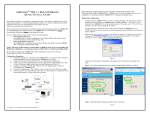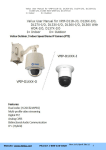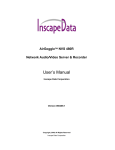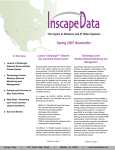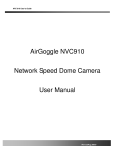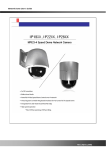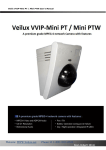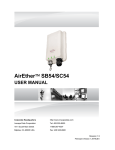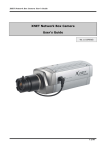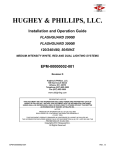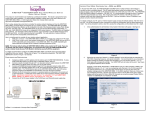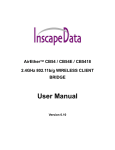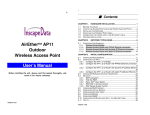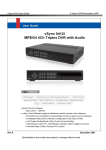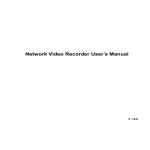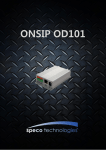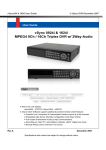Download User Manual - Inscape Data
Transcript
AirGoggle NVS 410 Network Audio/Video Server User’s Manual Inscape Data Corporation Copyright, 2004, All Rights Reserved Inscape Data Corporation NVS410 User’s Guide NOTE NVS410 is designed for indoor use only. When using NVS410 outdoors or in an environment that exceeds the limited range, you must separately use a water-resistant case. Be careful not to cause any physical damage by dropping or throwing the NVS410 A/V Server. Especially keep the A/V server out of reach from children. Do not disassemble NVS410. The unit will be excluded from After Service when disassembled. Use only the power adapter provided with the NVS410. If you would like to use the NVS410 A/V server for security and/or monitoring, please check the legal regulations within the country. NOTE This equipment has been manufactured and tested to comply with the limits for a Class B digital device, pursuant to part 15 of the FCC Rules. These limits are designed to provide reasonable protection against harmful interference in a residential installation. This equipment generates, uses and can radiate radio frequency energy and, if not installed and used in accordance with the instructions, may cause harmful interference to radio communications. However, there is no guarantee that interference will not occur in a particular installation. If this equipment does cause harmful interference to radio or television reception, which can be determined by turning the equipment off and on, the user is encouraged to try to correct the interference by one or more of the following measures: ! Reorient or relocate the receiving antenna. ! Increase the separation between the equipment and receiver. ! Connect the equipment into an outlet on a circuit different from that to which the receiver is connected. ! Consult the dealer or an experienced radio/TV technician for help. -2- NVS410 User’s Guide Caution None of the parameters in administrative page should be changed while NVS410 is recording video or while you are playing back recorded video from NVS410. Caution Any changes or modifications in construction of this device that are not expressly approved by Inscape Data could void the user’s authority to operate the equipment. -3- NVS410 User’s Guide Table of Contents 1. Introduction................................................................................................................................................... 5 1.1. Overview........................................................................................................................... 5 1.2. Features of NVS410 .......................................................................................................... 5 1.3. Applications of NVS410 ..................................................................................................... 5 2. Product Description....................................................................................................................................... 6 2.1. Contents ........................................................................................................................... 6 2.2. Content Preview................................................................................................................ 6 2.3. Physical description........................................................................................................... 7 2.4. PC Requirements .............................................................................................................. 9 2.5 Quick Installation Guide...................................................................................................... 9 3. Connecting the NVS410.............................................................................................................................. 12 3.1. Connection to a LAN ....................................................................................................... 12 3.2. Connecting to xDSL Modem ............................................................................................ 13 3.3. Connecting to Cable Modem............................................................................................ 14 4. IP-Installer .................................................................................................................................................. 16 4.1. Main window of IP-Installer .............................................................................................. 16 5. Configuring the NVS410 in Administrative Mode.......................................................................................... 17 5.1. Log On............................................................................................................................ 17 5.1.1. Using Internet Explorer...................................................................................... 17 5.1.2. Log on from “NVR100 Software” .......................................................................... 17 5.1.4. User ID and Password ...................................................................................... 18 5.2. Basic Setup..................................................................................................................... 19 5.3. Network Configuration ..................................................................................................... 22 5.4. User Admin & Time Setup................................................................................................ 25 5.5. Sensor & Capture Setup .................................................................................................. 28 5.6. Alarm Device Setup ......................................................................................................... 30 5.7. Motion Region Setup ....................................................................................................... 31 5.8. PTZ Setup ...................................................................................................................... 33 5.9. Upgrade & Reset............................................................................................................. 35 5.10. Status Report ................................................................................................................ 37 6. Tips for Using NVS410................................................................................................................................ 38 6.1. Relay output and Sensor input ............................................................................... 38 6.2. Trouble Shooting ............................................................................................................. 39 6.3. How To Upgrade Your NVS410 System............................................................................ 41 -4- NVS410 User’s Guide 1. Introduction 1.1. Overview The AirGoggle NVS410 is a state-of-the-art 1-channel A/V server, which transmits both video and audio data in real time with high-resolution and frame rate. This is possible through MPEG-4 CODEC technology, which provides data transmission at high compression rates and data resolution via networks. The NVS410 is IP addressable and can be controlled and monitored from a remote location through an IP address. Unlike CCTV or DVR, the NVS410 is easy to install and very cost effective. Based on Embedded Software Solution (Embedded Web Server, Embedded Streaming Server, Network Protocol), the NVS410 ensures high performance, stability, and integration of various Internet solutions. 1.2. Features of NVS410 " 1 channel real time Video/Audio streaming based on MPEG-4 video and ADPCM audio. " 1 channel Bi-directional Audio between NVS410 and Client PC for two-way communication " The viewer assisted recording and playback functions. " Motion detection – Up to 3 motion detection regions. Motion detection can initiate video recording, which is sent to the user through FTP and (or) E-mail. " Resolution : NTSC Video : 640x240(Half VGA), 320x240(QVGA) PAL/SECAM : 704x288, 352x288(CIF) " Remote Software Upgrade over Network " Remote P/T/Z control : Canon VC-C4/C4R etc., " Ease of use and convenient user interface. 1.3. Applications of NVS410 " Security surveillance (buildings, stores, factories, parking lots, banks, government facilities, military, etc.) " Real time Internet broadcasting (resort areas, events, etc.) " Remote monitoring (hospitals, kindergartens, traffic, public areas, etc.) " Teleconference (Bi-directional video conference) " Remote Learning " Weather and environmental observation -5- NVS410 User’s Guide 2. Product Description 2.1. Contents Open the package and check that you have the following: Components NVS410 Description AC Power Cable A/V server Input : 100~250V 50-60Hz Output : +12V, 1.0A AC 250V, 10A~16A LAN Cable 2m LAN cable – Crossover type CD-ROM Product Software & User’s Guide Quick Install Guide Easy to follow quick install guide AC Power Adapter Remarks Main Unit For direct connection between the server and PC. 2.2. Content Preview NVS410 IP-Installer NVR100 Software NVS410 IP address management Full feature NVR100 PC software to Network A/V server PC software view and record A/V streaming data and control the mode of operation. -6- NVS410 User’s Guide 2.3. Physical description 2.3.1. Front panel Figure 2-1. Front panel of NVS410 Status indicator: As shown in Figure 2-1, there are three status indicator LEDs. From left to right they are HDD, LAN and Power. HDD : This feature is not enabled for this model. LAN : Link indicator, continuous green light means that LAN is in normal state. When there is traffic on the LAN, orange light flickers. Power : Status indicator shows the status of the NVS410 in three different colors. Green : The green light indicates that the NVS410 is operating properly. If the green light is continuously on, it means that the NVS410 is ready to transmit data via network. If the green light blinks, it means that there is traffic between LAN and NVS410. Red : The red light indicates that the hardware of the NVS410 is not operating properly. Orange : The orange light indicates that the software of the NVS410 is not operating properly. When applying power to NVS410, power indicator temporarily lights on with red color and then returns to green. This is the normal condition. -7- NVS410 User’s Guide 2.3.2. Rear panel Figure 2-2. Rear Panel of NVS410 # Power : Power input of NVS410. 12V/1A # MIC/Line In : It is used to connect an external audio source or microphone to NVS410 # SPEAKER/Line Out : It is used for connecting external speakers with built in amplifier. Audio from remote site is output through Line out in bi-directional audio mode. Use Standard stereo headphone jack for the connection. # RELAY : It is used for connecting external alarm generators such as sirens and flashing lights. When activated, relay output configures a closed circuit. Two Relay outputs(A, B) are provided. # SENSOR : There are provisions for 2 alarm sensor device connections. They are used for connecting external alarm sensors such as the infrared sensors, heat sensor, magnetic sensors, etc. # RS-485 : It is used for connecting P/T/Z device having RS-485 interface standard. # RS-232(9 pins) : It is used for connecting P/T/Z device having RS-232 interface standard (Either one of RS-232 or RS-485 can be used as a P/T/Z interface at one time.) # VIDEO-IN : Video input (composite NTSC, PAL, SECAM) # # VIDEO-OUT : Video input (composite NTSC, PAL, SECAM) for bypassing signal from VIDEO-IN # Reset - LAN : 10Base-T Ethernet connector. Connects NVS410 to 10Mbps Ethernet Enable factory default setting. Doing so will erase all previously entered parameters and replace it with factory default settings. Not labeled for security reasons. Shown above in Figure 2-2 circled in red. -8- NVS410 User’s Guide 2.4. PC Requirements Audio/Video monitoring and recording can be achieved with the use of NVR100 Software program running on a PC. The Minimum PC requirement follows: Minimum Recommended Pentium III 700 Pentium IV 1.2G above 128 MB 256MB or more Windows 98 SE. Windows 2000 or later Web browser Internet Explorer 5.0 Internet Explorer 5.0 or later Video Resolution 1024 X 768 1600 X 1200 Network 10 Base-T Ethernet 10/100 Base-T Ethernet CPU Memory Operating system * * Operating Systems supported : Windows 98 Second edition, Windows NT Workstation 4.0 (SP 5.0 OVER) Windows 2000 Professional Windows XP Professional / Windows XP Home Edition 2.5 Quick Installation Guide Brief information for rapid installation is provided in this section. For more detailed information you are recommended to refer to pertinent documentations provided with the product or refer to Inscape Data’s home page (http://www.InscapeData.com). 1. Apply Power to the AirGoggle NVS410. 2. Connect the AirGoggle NVS410 Audio/Video Server to your PC or Network via one of the following method. i. Connect your PC and NVS410 using a crossover LAN cable. ii. Connect the AirGoggle NVS410 and configuration PC to a Hub or Switch via normal LAN cable. 3. Install “IP installer” and “NVR100 Software” on your PC. Detailed information for installing these programs can be found in [IP-Installer User’s Guide] and [NVR100 Software User’s Guide], respectively. 4. Assign an IP address to NVS410 via the IP installer software. Identify the type of the network environment and set up an IP address accordingly. Detailed process of -9- NVS410 User’s Guide setting up the IP address can be found in [IP-Installer User’s Guide]. If the network type is xDSL or Cable modem you will need supplementary information provided by your ISP. 5. Connect to NVS410 in Administrator Mode for initial parameter set-up. All parameters are set to factory default state when NVS410 is delivered to you. Detailed information of using administration mode can be found in section 5 [5. Configuring the A/V Server in Administrative Mode]. The parameters in the following table should be set-up with proper values. Detailed information for the parameters in Administrator Mode can also be found in section 5 [5. Configuring the A/V Server in Administrative Mode] NOTE: The set-up values are preserved even if the power is turned off. Menu Parameter Setup value Factory default value For security reasons, you are User Admin and Time Setup Administrator name & password recommended to change these values from settings. factory default Please note these Username : root Password : dw2001 new values in a secure place. User Admin and Time Current Time Input correct time in this field. 2001/1/1 Setup Define the video transmission Video Size resolution. This value should be below the Max Upload Rate Basic network speed in which the NVS410 is connected to. Setup Must be Set Manually Number of frames transmitted Frame Rate per second. Video transmitted bandwidth Video Rate allowed 6. Connect audio/video sources, sensors, and output devices to the NVS410 accordingly. NOTE: NVS410 may not function properly if there is no video and audio input. Please Reference to the following table for proper functional setup. You have to connect Video source. - 10 - NVS410 User’s Guide Connectors Video In Line In/Mic Line Out Sensor RELAY Output Function Input video connector Audio in Audio out for speaker Alarm Sensor Input External Alarm Or Alerting devices RS485 PTZ device control RS232 PTZ device control LAN/10 Base T Ethernet Interface Return the NVS410 RESET to factory default setting VIDEO OUT Video Output Connector Description Number of Ports Analog video outputs from analog CCTV camera, DVD, TV etc., 1 (NTSC/PAL/SECAM) Microphone or output from external audio devices. 1 When in bi-directional audio mode, Audio signal from remote site is available from this 1 connector. Use speaker with amplifier. Example: IR sensor, Motion Sensor, Smoke Detector, and Many more type of sensor. 2 Example: Siren, Beacon, External Relay. 2 Output signal controlling an P/T/Z device 1 Output signal controller an P/T/Z device (Canon VC-C4/C4R) Connect the NVS410 to an Ethernet Hub, Bridge, or Router Once pressed, it will reset all values of NVS410 to factory default setting. Bypasses the input video to feed into external video viewers or recorders. 1 1 1 1 5. Video connection to NVS410 You can connect to NVS410 in video mode by running “NVR100 Software” program on your PC. Detailed information of using “NVR100 Software” can be found in [NVR100 Software User’s Guide]. - 11 - NVS410 User’s Guide 3. Connecting the NVS410 NVS410 supports LAN, xDSL, and Cable modem. It also supports shared IP networks, where many internal network clients share a single public IP address. Refer to [IP-Installer User’s Guide] for details of setting the IP address for the NVS410. 3.1. Connection to a LAN Typically the NVS410 is connected to a network as follows: Figure 3-1. Typical NVS410 network connection 1. After it is powered on, connect the NVS410 to a LAN. 2. Assign an IP address to the NVS410 by using the IP-Installer. in the same subnet as NVS410. 3. Check if video streams can be viewed with NVR100 software. - 12 - Make sure the PC running the IP-Installer is NVS410 User’s Guide ② 3.2. Connecting to xDSL Modem 1. After power on, connect the NVS410 to a PC or Notebook via a crossover CAT 5 network cable provided with the system. 2. Setup network parameters by running “IP-Installer.” Figure 3-2. Direct connection using crossover LAN cable Regular LAN or crossover LAN cable Figure 3-3. Connecting the NVS410 to xDSL 3.Remove the LAN crossover network cable to the PC or Notebook and connect the NVS410 to the network using standard LAN network cable. Verify the connection by using the NVR100 network video software to see if the video source is viewable. - 13 - NVS410 User’s Guide In most cases when connecting the NVS410 to a xDSL Modem, a standard Ethernet network cable is required. But since a few xDSL Modems uses crossover connections, please verify the interface with your Modem manufacturer. 3.3. Connecting to Cable Modem 1. Apply power and connect the PC and NVS410 together via the crossover cable provided with the system. 2. Setup network parameters by running “IP-Installer”. (Refer to Figure 3-4). Figure 3-4. Direct connection using crossover LAN 3. Remove the crossover cable and connect the NVS410 to the network using standard LAN cable as shown in Figure 3-5. Check if you can receive video using the viewer program. In most cases when connecting the NVS410 to a Cable Modem, a standard Ethernet network cable is required. In some cases a crossover connection may be needed. Please verify the interface with your Cable Modem manufacturer. - 14 - NVS410 User’s Guide Regular LAN cable or crossover cable Figure 3-5 Connecting the NVS410 to a Cable Modem - 15 - NVS410 User’s Guide 4. IP-Installer NVS410 is IP addressable therefore needs an IP address for connection to the network. Inscape Data’s IP- Installer is a PC program developed to assign IP addresses and network parameters to digital video security network products such as Network Video Camera and Network Video Server from Inscape Data. IP-Installer is contained in the CD supplied with your product. Detailed information of Installing and running IP-installer can be found in [IP-installer user’s guide] 4.1. Main window of IP-Installer Figure 4-1. IP-Installer - 16 - NVS410 User’s Guide 5. Configuring the NVS410 in Administrative Mode 5.1. Log On There are 2 methods of login into the NVS410 administrative console. One is through standard internet browser and the other is through “NVR100 Software” program. 5.1.1. Using Internet Explorer You can log on to the server by clicking admin mode button or from your internet browser. Type in the following URL in your favorite web browser. http://[NVS410 IP address]/admin.htm Example: http://172.16.64.33/admin.htm If you changed the HTTP port from default value you can login by typing in: http://[NVS410 IP address]:[port]/admin.htm Example: http://172.16.64.33:8080/admin.htm 5.1.2. Log on from “NVR100 Software” Select a video channel in the viewing window of “NVR100 Software” using your computer mouse. Selected video channel will be highlighted. Click button on the right side of the display screen, which is shown in Figure 5-1, circled in red. Figure 5-1. “NVR100 Software” - 17 - NVS410 User’s Guide 5.1.4. User ID and Password On the initial login to NVS410, a windows prompt for User Name and Password appears as shown below in Figure 5-2. Figure 5-2. Log On Screen Factory default User Name and Password are set as ‘root’ and ‘dw2001’, respectively. Click on “OK” button to enter into the Basic Setup page of Admin Mode. If you have changed the username and password of the Administrator, you must log on with the changed username and password. - 18 - NVS410 User’s Guide 5.2. Basic Setup Setup the basic parameters of the NVS410. The web interface is shown below in Figure 5-3. Figure 5-3. Basic Setup " Language Selection: You can select a language in the admin page. - Supported languages: English, Korean, Japanese, Chinese, Spanish - 19 - NVS410 User’s Guide " System Name It is the name of the NVS410. It is the same as the one set-up by the IP-installer. You can reassign the system name in admin mode. " Audio Input Selection Select the type of input audio. - Line-In is used for connection of external audio devices and Mic is used if the external device is a microphone. Input Gain: Selectable gain for the input line. - " Video Quality & Bandwidth Control - Input Video Source : Select the analog video standard for input. Select one from NTSC, PAL, SECAM. - Video Size : Select a video size for transmission. Allowed video sizes are different for each video standard. - NTSC(30 frames/sec Max.) : 320x240 / 640x480. - PAL (25 frames/sec Max.) : 352x288 / 704x576. - SECAM (25 frames/sec Max.) : 352x288 / 704x576. # Max upload rate o # Assign maximum bandwidth of the uplink for the network connected to NVS410. Frame rate o Assign number of video frames transmitted for each second. You can improve picture quality by lowering frame rate for the same bandwidth. # Video rate o # Assign bandwidth for transmitting video data. Audio rate o Assign bandwidth for transmitting audio data. Audio data is not transmitted if you select “NA” " Check After you finish setup of video and audio for all the channels, click on this button to obtain the possible maximum number of users (Possible Max Users) and network bandwidth margin (Remained) remaining. The Check tool will calculate the number of users able to view the video stream without any quality degradation or network congestion. " Possible Max Users It shows the number of maximum simultaneous connections for the network connection set-up. - 20 - NVS410 User’s Guide " Remained It shows the network bandwidth margin when Possible Max Users are connected. " Limited users Useful network bandwidth varies according to the condition of the network. This parameter is used to limit the number of the simultaneous connections below the number shown in Possible Max Users. all cases, this value will be below Possible Max Users for optimal performance. " Save Save the set-up parameters when the set-up parameters are done. - 21 - In NVS410 User’s Guide 5.3. Network Configuration Setup the network parameters appropriately in accordance with your network environment. Many of the parameters in this page are the same as those used by “IP-Installer”. Figure 5-4. Network Configuration - 22 - NVS410 User’s Guide IP Assign Type : The network connection types supported by the NVS410 are Static, PPPoE, and DHCP. - Select ‘Static IP Setup’ for static IP address configuration and enter the IP address, Subnet Mask, Gateway, DNS1 and DNS2 into the appropriate field. will assign these values. Typically the network administrator or ISP provider DNS2 is used when DNS1 is unreachable and is recommended. - Select ‘PPPoE’ in the network connection type if the NVS410 will be directly connected to a WAN. Typically xDSL or broadband service providers will need this setting. Fill in the ‘User Name’ and ‘Password’ fields with the values assigned by the Internet service provider. - When the network connection type is “automatic IP allocation by DHCP”, select ‘DHCP’ in the network type. " Refer to [IP-installer user’s guide] for “Clone MAC”. " Refer to [IP-installer user’s guide] for “Host name and domain for Cable Modem”. " E-Mail Setup - Recv E-Mail Address: Refer to [IP-installer user’s guide] for “Recv E-Mail Address”. - Return E-Mail Address: Refer to [IP-installer user’s guide] for “Return E-Mail Address”. - Notify for IP Changed: If you check this, the IP address will be sent via E-mail to this address whenever the IP address of the NVS410 changes. - Title: It is the predefined subject of the e-mail message sent to user. - Message: It is the pre-defined content of the e-mail message sent to user. " FTP Server Setup : Setup IP address, Username, Password and Directory of FTP server to send data when an alarm or sensor triggers an event. " Port Change : You can change the HTTP port, RTSP port, and RTCP port numbers. The RTSP port is used to connect the “Viewer“ to the NVS410. Each port should have a number below # 65535. - HTTP : default “80” - RTSP : default “554” - RTCP : default “6971” Management Server : This feature enables the built-in dynamic DNS client to automatically update the IP - 23 - NVS410 User’s Guide address of the NVS410 to a remote management web server. Currently mgmt-net- video.net is a free Dynamic DNS registration server for the NVS410. Simple web management interface keeps all your network cameras and servers in one easy-to-track interface. This is a great option if you have multiple cameras and are using Dynamic DNS. IP Filtering : You can restrict the access to the administrator page utilizing IP address filtering. - Restrict Administrator Access : Check this box to restrict administrative log on privileges. - Base IP Address : Input an IP address of the PC which will be used for administrative access. - Mask : This is same as subnet mask. It is used to allow administrative log on only from PCs located in the same subnet as the base IP address. If only one PC is allowed to access the administrative mode, set this value to 255.255.255.255. - 24 - NVS410 User’s Guide 5.4. User Admin & Time Setup You can change the ID and password of users and also assign different attributes for each user. Figure 5-5. User Admin. & Time Setup User Administration - Administrator . Username : Admin ID. Default ID is “root” . Password : Admin password. The default password is “dw2001”. . Confirm Password : Enter the password once more to confirm the password. If you have forgotten the Administrator’s ID and password, the only means of recovery is to reset the settings to factory default. Doing so will lose your previous settings. - 25 - NVS410 User’s Guide - Add User . Username : Enter the user ID you want to add. Up to 100 users are supported by NVS410. . Password: Enter the user password. . Attribute : You can set different system resource access capabilities for each of the user. Attributes are Audio, Bi-directional Audio and Pan/Tilt. For example, if you want a specified user to hear the audio from the NVS410, check Audio in the check box. - User List : You can list “user ids” and “ their attributes” here. List format are as follows: user id[A, BA, P] : A – audio, BA – bi-directional audio, P – P/T/Z. you can delete specific user by selecting and clicking the “DELETE” button. Authentication for Viewing : If you want to restrict viewing access to the NVS410, Check the “Yes” box and click “Save”. Users will need to input User ID and password to connect to the NVS410 in viewing mode. (Figure 5-6.) Figure 5-6. User Authentication in NVS410 - If No[default attribute] : If you uncheck “Yes” in “Authentication for viewing”, every user can access the NVS410 without restriction or with the same attributes. You can enable the common attributes by selecting each attribute and clicking the “Save” button. Please Note: By adding users for authentication does not automatically enable the authentication service for the NVS410. It is by both adding users and selecting “YES” for Authentication that the authentication service is enabled. - 26 - NVS410 User’s Guide " Time Setup - Current Time: It displays the current time of NVS410. - Time Settings : Options for setting the time manually or synchronize to the PC. Options Description “Synchronize With Computer Time” Synchronize the time with the PC time. “Set Manually” You can manually set the time. - 27 - NVS410 User’s Guide 5.5. Sensor & Capture Setup This is the setup page for conditions of video capture. The video capture can be triggered either by activated alarm sensor or motion detection as setup by this page. When the sensor is triggered the event is ported to the NVR100 Software. Captured video of the event is stored on the HDD of PC or FTP server. Figure 5-7. Sensor & Capture Setup " Sensor Setup : Up to 2 external sensors can be connected to the NVS410. - Type Selection : Select sensor type. There are two sensor operating mode. . Normal Open : Open circuit in normal operation. . Normal Close : Closed circuit in normal operation. Closed circuit indicates alarm triggered condition. Open circuit indicates alarm triggered condition. " Video Capture Condition : It sets which sensor will trigger video recording for channels 1-2. The NVS410 supports 2 types of sensor event trigger. 1. Sensor : when at least one of the sensor detects a trigger event. - 28 - NVS410 User’s Guide 2. Motion-detection : Motion triggered event from the video channel 3. Periodic transfer select: Video is recorded on a preset time basis. NOTE: All three conditions are mutually independent in operation. " Captured Video Transmission: Enable the ability for the NVS410 to send the captured video through FTP, E-mail, or both. FTP: Sent via FTP. Refer to [Section 5.3] E-mail: Captured video sent to the E-mail address. Refer to [Section 5.3.] If the FTP server is not properly configured in “Network Configuration” mode, this mode will be ignored. Captured video data for E-mail consists of intra frames only in consideration of the limited storage space for E-mail account. FTP data contains entire video frames. Video for periodic recording is sent only to FTP server. - 29 - NVS410 User’s Guide 5.6. Alarm Device Setup The configuration of alarm device output when triggered by an alarm device input(sensor or motion detection) can be configured in this page, including output device port test and triggered condition. Figure 5-8. Alarm Output Setup " Alarm Device Test : Test alarm devices. Press On/Off for testing. device 1 and 2 to “ON” and “OFF” state. This option will manually trigger the output It can be used in new setup or troubleshooting external devices. " Alarm Device Active Condition : Setup the condition in which to trigger the output device 1 and 2. A combination of input sensor and motion detection can trigger the output device to activate. - Duration : Set the active duration of Alarm out from the moment of the trigger. 10 sec, 30 sec, 1 min, 2 min, 5 min, 10 min, 30 min, 1 hour. - 30 - NVS410 User’s Guide 5.7. Motion Region Setup Set the motion detection regions. Up to 3 separate regions can be defined. After setup the motion detection region, the corresponding selection in “Sensor & Capture Setup” ->“Video Capture Condition” -> “Motion Detection Select” should be enabled, to activate the motion detection and generate the alarm condition. Figure 5-9. Motion Region Setup " Channel Selection : Choose the channel you wish to enable the motion detection feature. " Channel Sensitivity : Set the sensitivity in motion detection for each channel. - 1 being the least sensitive and 66 is the most sensitive. - Sensitivity values can be set to different values among different channels, but same sensitivity is applied for the regions within the same channel. " Motion Region Setup : Set up to 3 motion detection region per each video channel - Region 1, 2, or 3 : Motion detection is enabled for the channels by checking each box. - 31 - NVS410 User’s Guide . You can set the region by pressing the “START” button, and click one corner of region in the left viewing. It will show the coordinate value automatically. Next you press the “END” button, and click the opposite diagonal corner. Regions are shown in three different transparent colors for easy identification: red(region 1), green(region 2), blue(region3) “RESET” button clears the start & end point to (0,0) & (0,0) . Percent : This value controls the object detection size sensitivity of each region. 1 is the most sensitive and 100 is the least sensitive. If one wishes to detect a tennis ball sized object, choose a lower value, where as to detect humans and cars choose a higher value. - 32 - NVS410 User’s Guide 5.8. PTZ Setup Setup and test the P/T/Z(Pan, Tilt, Zoom) devices. Figure 5-10. PTZ Setup " Channel Selection : Choose the channel having PTZ device. " PTZ Model Selection : Choose the PTZ model for each channel. Different PTZ model can be applied for each channel. - Delete Button : Press this button to delete the setup of PTZ. " PTZ Device ID: Set PTZ ID associated with each PTZ device. Refer to [5.9 Upgrade & Reset] for adding new PTZ device. " PTZ Operation Check : You can check the various operation of the PTZ devices. “LEFT”/”RIGHT”/”UP”/”DOWN” , “AUTO FOCUS”/”ZIN”/”ZOUT” - 33 - NVS410 User’s Guide " PTZ Position Setup : You can set up the PTZ limitation & preset positions if the PTZ device supports it. - Panning Limitation : set the left/right limitation and test. - Preset Position : set the preset position and test. NOTE : “PTZ Position Setup” feature is applicable only for the PTZ devices that support it. - 34 - NVS410 User’s Guide 5.9. Upgrade & Reset You can upgrade the NVS410 via the network. Figure 5-11. Upgrade & Reset The upgrade software, after release, may be downloaded from Inscape Data’s web site. (Refer to [6.3. How To Upgrade Your NVS410 System] # Automatic Upgrade (Reserved for future service) # Manual Upgrade o System S/W Upgrade : Upgrade the system software installed in the server via the network. Refer to [6.4 How to Upgrade Your NVS410 System] NOTE: To apply the upgraded S/W, you should reset the system after system S/W upgrade. - 35 - NVS410 User’s Guide # Bootloader Upgrade: Upgrade the bootloader installed in the server via the network. Refer to [6.4 How to Upgrade Your NVS410 system] # Add PTZ File : Add a new PTZ descriptor via the network. Refer to [6.4 How to Upgrade Your NVS410 System.] " Factory Default Setting : Re-initialize NVS410 to factory default state. " NOTE: To apply Factory Default Setting, you should reset the system. Once the NVS410 is re-initialized to factory default state, it should be set-up again using IP-Installer. " System Reset : Perform remote reset by clicking the “CONFIRM” button. All users logged on to the NVS410 will be disconnected upon reset. NVS410 does not resume the connections automatically. The users must re-connect to the server manually. " NOTE: To apply the upgraded S/W, you should reset the system after system S/W upgrade. - 36 - NVS410 User’s Guide 5.10. Status Report It reports the system records and logs since the system power up. Figure 5-12. Status Report You can use the status report page to troubleshoot, diagnose the NVS410, monitor the software versions, and even the status of the whole system. - 37 - NVS410 User’s Guide 6. Tips for Using NVS410 6.1. Relay output and Sensor input SENSOR connectors are used to connect various sensing and alerting devices. Examples of sensing devices are infrared sensors, motion sensors, heat/smoke sensors, or magnetic sensors. RELAY output is used for connecting alerting device such as loud speaker, flashing lights, etc. Figure 6-1. Sensor and Relay Connector 1. Sensor Connect the two wires of the sensors. The sensor type can be set in Administrative Mode (Ref. 5.5 & 5.6). Output lines providing on-off switching are connected between “+” and “-“ pins. circuit of “Alarm In”. Figure 6-2. Sensor input of NVS410 - 38 - Figure 6-2 shows the input NVS410 User’s Guide 2. RELAY Relay outputs are provided for connecting alarm devices or for remote on/off devices such as light control. Relay circuits are initially open. Circuitss are closed upon alarm trigger or remote “ON”. The relay is capable of switching AC/DC 30V and 1A electrical signal. Figure 6-3. Relay Output of NVS410 3. Connection of Sensor and Alarm Device 6.2. Trouble Shooting • NVS410 in viewing mode, neither channel name nor video is displayed and eventually the timeout message shows up. Check the power and network connection of NVS410. To check if the network is properly operating, open the browser and try to connect to any server. Example) http://www.InscapeData.com Or open the MS-DOS Prompt and type the following. ping www.InscapeData.com Then press Enter. If you see the “ Reply from …” message it means that the network is working properly. To check if the NVS410 is connected, open the MS-DOS Prompt and type the following. ping [the IP of the server] Example) ping 192.168.1.112 If you see the “Reply from …” message, it means that the server is properly connected. If you do not see a Reply message, check if the network cable and power cable are properly connected. • Name of the channel on NVS410 is displayed but there is no video. Check if there is an input video source to the channel. And check if there is a firewall in the network. Check - 39 - NVS410 User’s Guide if the network is NAT type. In case there is a firewall in the network: Please refer to “Firewall” Application Note in the CD. If the network is NAT type, you need port mapping. Please refer to “IP sharing device” Application Note in the CD. 2. After Successfully Connecting to the NVS410 • Video movement is slow. ! In Basic Setup of Admin Mode, lower the “Quality”. High quality means more data. You can also set the “Max. Bandwidth” to higher value. But this value must be lower than the maximum upload speed of your network. For example, if the maximum uploading bandwidth of the network is 400Kbps, set the total “Max. Bandwidth” of the 4 channels to 384Kbps. If you set it higher, the video image could be corrupted with artifacts. Ask your network manager or ISP for maximum uploading bandwidth of the network. ! Check whether dual streaming mode is enabled and NVS410 is recording video. Dual streaming mode is enabled by selecting “Enable High Quality Video Recording” in the basic set-up page (Refer to Section 5.2). When dual streaming mode is enabled, NVS410 provides low speed video to connected user while recording high quality video into HDD. • The image is dull and I see green, pink dots. This could be caused by performance limitation of the PC. Do not run too many programs while running viewer program. The other reason could be missing data while transmission from NVS410. • Mosaic phenomenon. Mosaic phenomenon occurs when not enough network bandwidth is available considering the resolution and frame rate of the video. Example is 640x480 video with low Max. Bandwidth. Users are recommended to adjust resolution and frame rates to lower values for lower bandwidth network. - 40 - NVS410 User’s Guide 6.3. How To Upgrade Your NVS410 System 1. Log on to administration mode and select “Update & Reset” menu. 2. Click "Browse..." to find the files you want to use for upgrade. This will open a "Choose file" dialogue window. The file extension is “ief”. 3. When you've found the file, click "Open." This will select the file and close the "Choose file" dialogue window. 4. Click the "INSTALL" button. An alert message box will pop up. Click “OK” button then it will start uploading the file. This may take some time. 5. Upgrade completion message will appear after the system upgrade has been completed. 6. Reboot NVS410 by performing “System Reset”. 7. After rebooting, log on to the administration mode again and click the “Status Report” in the left side. 8. Check the version and release date of the NVS410 ™. You can download NVS410 system software from Inscape Data’s homepage. http://www.InscapeData.com/product/download.html - 41 - NVS410 User’s Guide - 42 -










































